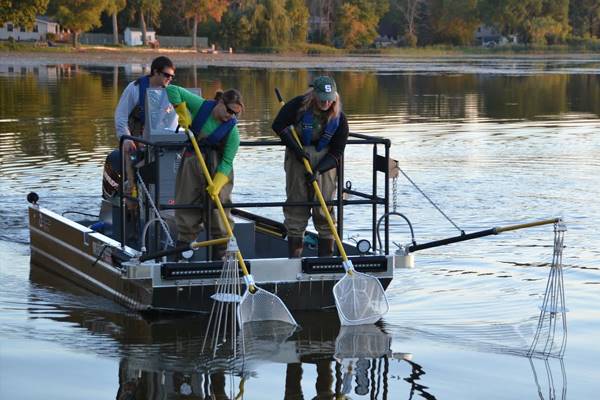Nearshore habitat loss impacting largemouth bass in Michigan lakes and elsewhere
Many lakes across the United States, and certainly those in the Great Lakes basin, have been impacted by the removal of underwater vegetation and nearshore habitat. And though the changes may alter shorelines in ways that people find more aesthetically pleasing, they may spell bad news for largemouth bass populations.
A researcher at Michigan State University’s Department of Fisheries and Wildlife is looking into the effects that shoreline degradation is having on largemouth there, architecting a study that took place in a five-county region near Baldwin, Michigan.
“The area has a good mix of developed lakes and undeveloped lakes,” said Joe Nohner, doctoral student at the university. “Largemouth bass seem to thrive with expanded vegetation cover and this area has a good mix of lakes with high and low vegetation cover. We think vegetation would be more limiting in the northern part of the state than near Lansing or the southern part of the state.”
He and other scientists working on the project have a simple hypothesis to test: Submerged aquatic vegetation and structure are preferred habitats for both juvenile and adult largemouth bass. They’re looking at recruitment to the fishery by studying the number of young fish in their surveys, as well as fish health and stomach contents in the analysis.
The investigation began with researchers spending three weeks using a Trimble GPS with ArcPad software to map all the shallow-water vegetation in 16 lakes. Researchers targeted spots under five feet in depth and also recorded information on the shoreline, docks and woody debris.
Two research programs were implemented this year, said Nohner. “One was a manipulative study using net pen enclosures in Blue Lake where we looked at different growth rates, fish conditions, and diets in habitats with varying amounts of vegetation,” he said.

Nohner and his research team conduct electrofishing surveys on 16 Michigan lakes to investigate relationships between largemouth bass and vegetation, wood, and other habitat characteristics. (Credit: Nathan Snow)
Only age-zero largemouth were looked at for the pen enclosure portion, with scientists looking at their responses to living in areas with no vegetation coverage, 50 percent coverage and 100 percent coverage.
The other program implemented used electrofishing and quite a bit of fieldwork to sample adult and juvenile largemouth bass to see how they fared in areas with differing habitat conditions.
“We made eight transects on each of the 16 lakes beginning in July to establish the adult population,” said Nohner. “Then we went back in October and November to get more information on the stock and to get more recruits because you have to wait until they grow out more for a reliable estimate.”
Along the way, Nohner made some key observations. Both juvenile and adult largemouth bass seemed drawn to vegetation and emergent vegetation. With more vegetation, he also suspects that there’ll typically be a higher density of age-zero largemouth bass. One reason for this could be because vegetation in general provides more support for macroinvertebrates and other food sources that young largemouth rely on.
“Vegetation also provides cover for them to hide from predators and to be predators themselves,” said Nohner. “But there is conflicting research on that.”
Full results from the investigation are forthcoming, and Nohner says he plans to share the data with lake associations that helped with the work. The Michigan Department of Natural Resources as well as the U.S. Geological Survey, which is supporting the work, will also see the results.
“The underlying driver of this work is that shoreline habitat development and habitat change are occurring as people change shorelines and remove submerged aquatic vegetation and woody habitats,” said Nohner. “With all the choices that people make, we’re trying to understand the habitat degradation that’s increasingly common across Michigan and the Great Lakes region.”

0 comments